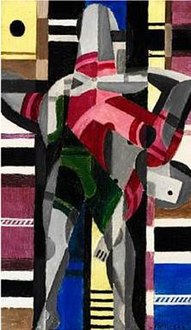|
Thorvald Hellesen
Thorvald Hellesen (25 December 1888 – 22 October 1937) was a Norwegian abstract artist, designer and painter. His art was associated with the Orphic Cubism movement.[1] BiographyThorvald Hellesen (sometimes spelled Thorwald) was born in Kristiania (now Oslo), Norway. He was the son of Thorvald Hellesen (1862–94), a barrister at the Supreme Court, and Ida Selmer (1858–1945), the daughter of Prime Minister Christian Selmer.[2] He passed the Examen artium, but spent a year at the Norwegian Military Academy before deciding to become an artist. He then enrolled at the newly created Oslo National Academy of the Arts, where he studied with Christian Krohg. This was followed by a move to Paris in 1912. There, he worked with Fernand Léger and became acquainted with Picasso.[3]  CareerFrom 1920, Hellesen attended exhibitions in the Salon des Indépendants and the Galerie la Boëtie in Paris. In 1925, he participated at the Exposition Internationale L'Art d'Aujourd'hui in Paris. He would remain in Paris for the next two decades, with occasional visits to Norway and Denmark. He had held only one exhibition of his works at home in 1919; choosing to exhibit mostly with the Salon des indépendants and the Section d'Or.[2] He appears to have exhibited very little after a major showing of avant-garde art in 1925. In addition to his paintings, he did decorative work, notably at the Sjøfartsbygningen (Maritime Building) in Oslo, as well as designing patterns for textiles and wallpaper.[3][4]  He married painter Hélène Perdriat in 1915.[2] The marriage was a troubled one, however, and was eventually dissolved.[5] In 1937, he married his presumed mistress, a dancer named Guni Mortensen.[6] During the course of that affair, he found himself gradually becoming estranged from the local art community and had to take odd jobs as a movie bit player.[7] In the fall of 1937, after an extended period of poor health, he fell seriously ill and returned home; dying shortly thereafter.[3][8] Posthumous exhibitionsAfter he died, a number of galleries exhibited Hellesen's work, including Galerie 1900-2000, which mounted a career-spanning solo retrospective in 1986 that featured thirty-six works produced between 1915 and 1928. Composition abstraite (circa 1923), pictured above and included in the show's catalogue, was also shown at Salon de Independants. [9] In November 2023, 85 years following his death, the National Museum of Norway became the first museum to hold an exhibition featuring his work: Thorvald Hellesen. Pioneering Cubism.[10] The museum wrote of the exhibition: "After being celebrated as ‘a new Munch’ in Kristiania (Oslo), the 23-year-old Hellesen went to Paris where he lived for the rest of his life. The French capital was the world metropolis for art, a magnet for artists from near and far. In the years leading up to the First World War, the city was marked by pompous splendour, cultivated taste and relaxed morals. In the artist studios and cafés, the foundations were laid for the first avant-garde movements of the 20th century." [10] "In Paris, Hellesen entered a milieu of artists, critics and authors, and he became close friends with Constantin Brâncuși and Fernand Léger, among others. He defined himself as a Cubist and joined a movement that upturned almost all established ideas about what art should be." [10] "As an artist, he moved restlessly from one Cubist strategy to another. As soon as he mastered the codes of one strategy, he abruptly dropped it and immersed himself in a new one. Around 1920, he finally received a certain amount of recognition in Paris: ‘Of all the Cubists, Hellesen is one of the most interesting, especially because he seems to have achieved a clarified aesthetic in which colour and form interact in a systematic way’, wrote the French artist Amédée Ozenfant." [10] "41 years after his death, Hellesen was rediscovered and some of his paintings were purchased by the National Gallery in Oslo. When the National Museum now opens the first museum exhibition devoted to Hellesen’s art, it takes place 85 years after the artist’s death (as of 2023)."[10]
Gallery
ReferencesFurther reading
External linksWikimedia Commons has media related to Thorvald Hellesen. |
||||||||||||||||
Portal di Ensiklopedia Dunia




